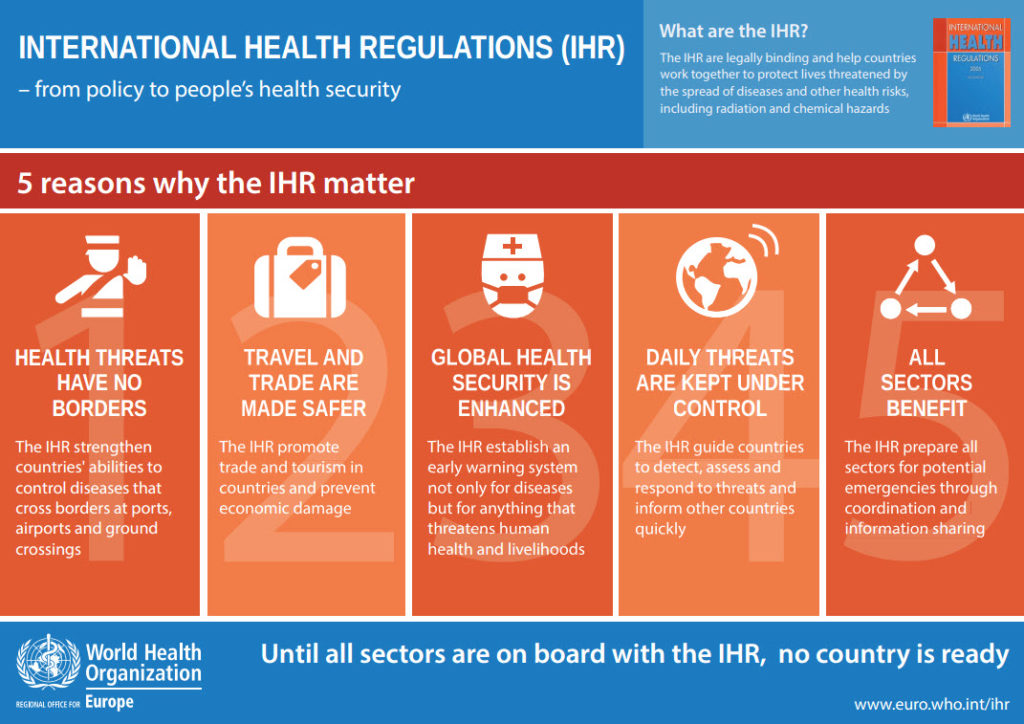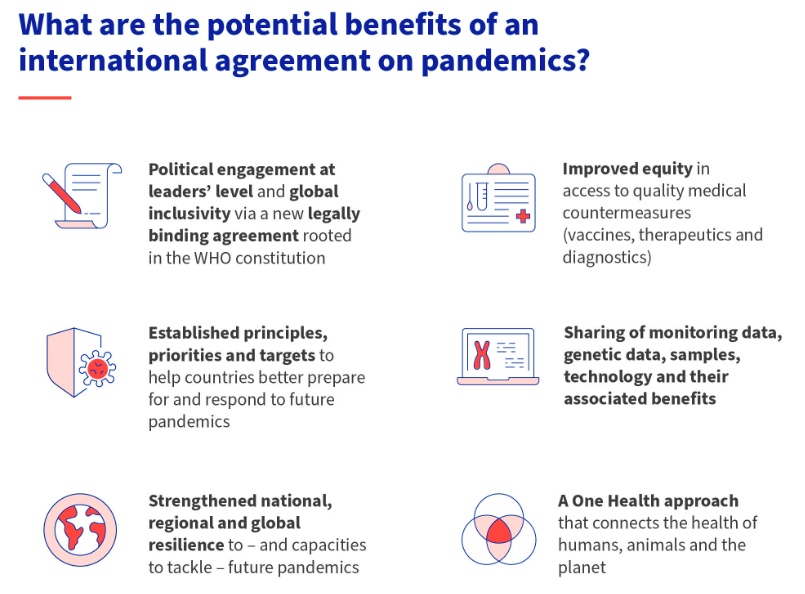ForumIAS announcing GS Foundation Program for UPSC CSE 2025-26 from 19 April. Click Here for more information.
Contents
| For 7PM Editorial Archives click HERE → |
Introduction
COVID-19 is being considered as the most severe pandemic the world has encountered in the last 100 years. As of September 2022, more than 603 million cases have been reported worldwide, with approximately 6.4 million deaths. The impact of the pandemic has been much beyond the loss of life. It has pushed an estimated 120 million people into extreme poverty. Economies across nations fell massively as the strict lockdowns virtually brought the economic activities to a standstill. No single Government or institution has a wherewithal to address such a crisis single-handedly. This has given rise to the larger perspective that ‘nobody is safe until everybody is safe’. The world is now facing three global health emergencies (COVID-19, Monkeypox and Polio). COVID-19 pandemic exposed the deep cracks in the global health systems including the International Health Regulations (IHR). Members of the World Health Organization (WHO) are now working towards a Global Pandemic Treaty that will prepare the world to combat such pandemics in a better manner in future.
What is the current framework to combat global pandemics?
At present Global public health responses are guided by the International Health Regulations (IHR). The Regulations were adopted in 1969 and revised in 2005 after the SARS outbreak. The regulations provide an overarching legal framework that defines countries’ rights and obligations in handling public health events and emergencies that have the potential to cross borders.
The IHR are an instrument of international law that is legally-binding on 196 countries. They create rights and obligations for countries, including the requirement to report public health events. The Regulations also outline the criteria to determine whether or not a particular event constitutes a ‘Public Health Emergency of International Concern’ (PHEIC). The Regulations require countries to improve their core capacities, including legislation, coordination, and surveillance, to detect and respond to national health emergencies. The IHR also define the steps for reporting disease outbreaks to WHO and disease control measures.
The IHR are based on 4 pillars: Detect, Assess, Report and Respond.
Source: cdc.gov
IHR require countries to maintain core capacities for surveillance and response. Additional provisions address the areas of international travel and transport such as the health documents required for international traffic. The IHR are important for several reasons.
Source: WHO
What are the shortcomings in the existing framework?
The International Health Regulations are legally binding and signed by 196 countries. Hence they provide the most comprehensive framework to deal with a pandemic. Yet there are several lacunae.
First, The current IHR system has little power to ensure governments comply with their responsibilities. The Governments do not accurately report on their core capacities to prepare for and respond to health emergencies. Often, there is a delay in sharing information with the WHO regarding local outbreaks. This delays global response as happened in case of COVID-19. The gap can be attributed to lack of strict implementation mechanism.
Second, International Health Regulation (IHR) obligations are heavily tailored towards prevention and detection of pathogens, and very limited on response stages to prevent transmission.
Third, The IHR is governed by the Ministries of Health of the member States. The Health Mininstries often have little influence on the underlying problem of a lack of broader political will, including to commit resources that could improve core capacities in accordance with the principles of IHR.
Fourth, The IHR primarily addresses capacities at a national level, which does not improve global oversight and coordination.
Fifth, despite attempts by WHO to devise improved methods of monitoring state compliance with IHR, there have been modest changes. These efforts under IHR do not appear to have had much effect on state preparedness or response.
COVID-19 Pandemic has led to recognition of the fact that IHR need further revision and that is the reason for the negotiation of new treaty.
How will a Global Pandemic Treaty be useful?
In December 2021, the World Health Assembly held a special session (only 2nd such special session since its inception in 1948) and took the decision to form a global pandemic treaty to ‘strengthen pandemic prevention, preparedness and response’.
An Intergovernmental Negotiating Body (INB) will be responsible for drafting and negotiating a treaty under Article 19 of the World Health Organisation’s (WHO) Constitution. This will be second such initiative under Article 19. The first was the WHO Framework Convention on Tobacco Control which came into effect in 2005.
Article 19 of the WHO Constitution It mentions that the Health Assembly shall have the authority to adopt conventions or agreements with respect to any matter within the competence of the Organization. A 2/3rd vote of the Health Assembly shall be required for the adoption of such conventions or agreements. |
The new pandemic treaty is expected to cover aspects like data sharing, genome sequencing of emerging viruses, equitable distribution of vaccines and drugs and related research throughout the world.
This treaty is an attempt to plug existing gaps, as well as to strengthen global coordination measures that have been weakened over time, in order to have a better global response to these massive issues.
A treaty could also enhance the capacity of more countries (especially in low- and middle-income countries) to produce diagnostics, therapies, and vaccines, built by a global commitment of funds, expertise, and technology transfer.
It will help to reach consensus on high-level legally binding principles and commitments within the Convention.
Source: European Council
What dimensions should be covered in a Global Pandemic Treaty?
First, Prevention of pandemics and their early detection should be the topmost priority. This could be achieved with a more robust country-reporting mechanism, as well as through the more widespread use of joint external evaluations and better follow-up.
Second, Ensuring universal and equitable access (addressing vaccine inequities) to medical solutions, such as vaccines, medicines and diagnostics will ensure resilience to the future pandemics.
Third, there is a need to ensure better surveillance of pandemic risks. The monitoring of risks and knowledge-sharing on new infectious diseases spreading from animals to humans is crucial to the prevention of future pandemics. This could be achieved through: (a) Increasing laboratory and surveillance capacity required to identify animal diseases in all countries; (b) Increasing cooperation between research institutions worldwide. This will aid in the worldwide data collection process, which will help with a better understanding of the disease; (c) Better coordination of international funding for core capacities . This will ensure a better health system in developing or underdeveloped countries also.
Fourth, Better alert systems should be developed. Digital technologies and innovative tools for data collection and sharing as well as predictive analytics can support real-time communication and early warnings which should, in turn, trigger a more rapid response.
Fifth, the WHO alarm mechanism must be reformed by making the process of declaration of Public Health Emergency of International Concern (PHEIC) and enforcing travel restrictions more robust.
Sixth, A new pooled insurance mechanism could be established to share the risks associated with infectious disease outbreaks, while simultaneously using these financing resources to encourage compliance with a global pandemic treaty.
Source: European Council
Some states have been reluctant for the instrument to be a legally binding framework convention because it would require ratification by every member state. They argue this would be a substantial political hurdle. However, in the absence of a legally binding framework, many countries might not comply with the requirements, thus rendering the treaty ineffective. Hence it must be legally binding.
Conclusion
The COVID-19 pandemic brought forward the gaps in the existing mechanisms to tackle global pandemics. The fact that the comity of nations under the aegis of WHO have agreed to negotiate a Global Pandemic Treaty indicates that have realized the existing system needs to be fixed. Now it must be ensured that the agreed framework fixes the lacunae. Most crucial aspects would be addressing vaccine equities, transparency in early reporting mechanisms and enhanced domestic capacities, especially in the developing/least-developed countries. Inability to address these gaps will leave the world vulnerable to a similar or even more deadly pandemic in future.
Syllabus: GS II, Global groupings and agreements involving India and/or affecting India’s interests,
Source: The Hindu, The Hindu, European Council, Lancet








